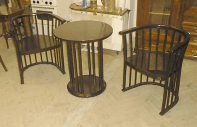
|

|
|
|||
Turn-of-the-century:Art Nouveau, Secession and Wiener WerksttteArt Nouveau (known in Austria as Secession ) is the style that rose at the end of the nineteenth century and persisted until the First World War. It was a reaction against the prevailing practice in architecture and applied arts of using conservative design motifs from Gothic, Baroque, Neo-Classical and other standard historical styles. As a movement, Art Nouveau sought to find a new, modern style that escaped from the formal, rigid past by emphasizing natural, organic forms such as plants and flowers. Generally speaking, earlier works of Art Nouveau tend to be more lush and dramatic, whereas later examples are more likely to be more subtle and stylized. However, the style's manifestations differed dramatically from one European country to another. In Hungary, Finland and several other countries, for example, artists and architects adopted many of the pan-European ideas behind Art Nouveau but also sought to create a genuine "national style," with heavy emphasis on folk art motifs. French Art Nouveau tended towards the curvilinear and highly decorative. One of the most prolific and complex centers of turn-of-the-century applied arts is Vienna. There, the artists and architects of the Secession sought to rebel entirely - that is, morally, aesthetically, intellectually and politically - against standard practice in the fine and applied arts. Among the leaders of this group was Gustav Klimt. An influential movement that came out of the Secession was the Vienna Werksttte , or Vienna Workshop . The workshop was a collaborative effort based on the concept of completely original artistic designs executed in fine materials being mass-manufactured for the public at a very high standard. Implicit in this was the idea that the artist could have an important influence on everyday, practical, functional objects.
Its main members included Josef Hoffmann and Koloman Moser . Hoffmann and Moser designed furniture, the designs of which were executed in the factories of J. & J. Kohn and Michael Thonet . The latter's sleek bentwood beech furniture had already been manufactured since the mid-nineteenth century. The Wiener Werksttte's designs tended to be slender, geometric and graceful, with motifs referencing such diverse influences as Japanese and ancient Aegean designs. The group produced furniture of a scale and design that is strikingly beautiful as well as timeless, but at the same time eminently comfortable and appealing. Between the two world wars:Art Deco and BauhausArt Deco , like Art Nouveau, was an international style - and it was produced by architects and craftsmen in the United States far more than Art Nouveau ever was. In spite of this, it is generally agreed that the finest Deco works came from France in the 1920s. The roots of Art Deco furniture making can be found in the French ancient regime and the work of late eighteenth-century cabinet makers. The exuberance of Art Nouveau was often considered to have been a digression from the path of traditional French taste and there was a strong desire for purity of understated form. However, this didn't mean an abandonment of decoration, by any means. Art Deco's refined, simple forms demanded elegant, rich materials. The favorite wood of Deco cabinet and table makers was ebony, rare even then, the jet-black surface of which can be buffed to a majestic shine. Often, dark tropical woods were used in juxtaposition with a contrasting burl wood, such as maple or ash. Wrought iron and lacquer were among the other fashionable materials. Still, Art Deco wasn't a monolithic movement - its primary designers can be grouped into categories of traditionalists, individualists and modernists.
Traditionalists, whose work consisted primarily of rich veneers inlaid with tortoiseshell or horn, considered themselves strictly the heirs of the eighteenth and early nineteenth century cabinetmakers. In that sense Art Deco has an element of Neo-Classicism, just as some interwar architecture also reflected an interest in the classical. Individualists such as the Irish Eileen Gray used more avant-garde materials and also allowed more diverse influences - such as that of African or Japanese forms or of Cubism - into their work. In stark contrast to the traditionalists, who revered rich natural materials, the Art Deco modernists engaged in a love affair with the machine. Metal, especially chromed tubular steel, was the dominant material. Modernism in part comes from Weimar-era Germany, where the dominant interwar movement was the Bauhaus , the art school founded by Walter Gropius in 1919. Bauhaus, in furniture and architecture, promoted a utopian aesthetic ideal that involved both modernism and handicraft and was free of non-functional decoration. It was heavily persecuted and the school was eventually closed down by the Nazis, who consistently opposed modernism, labeling it Bolshevik art. |
|
|
|
| E-mail : taylorj@firsteuropeanshipping.com |
|
|
|
Copyright c © 2024 © 2024 First European Shipping Kft Web Site Designed by Artsiter Internet Agency |

